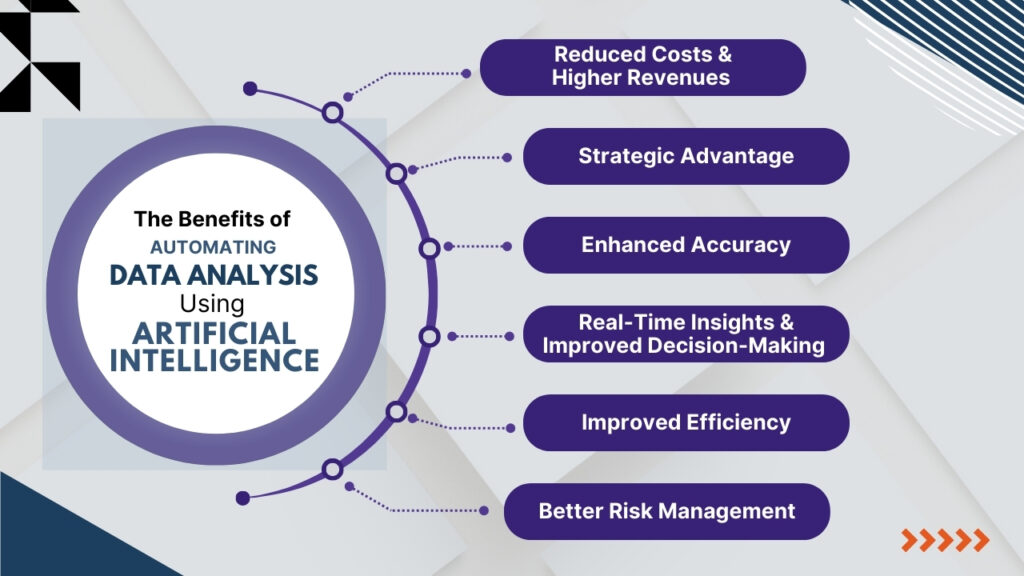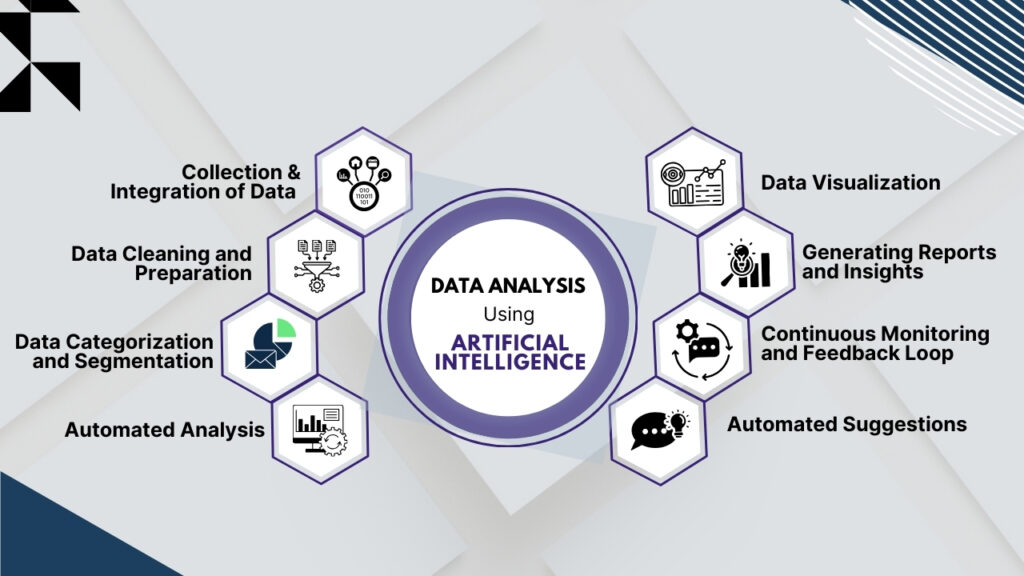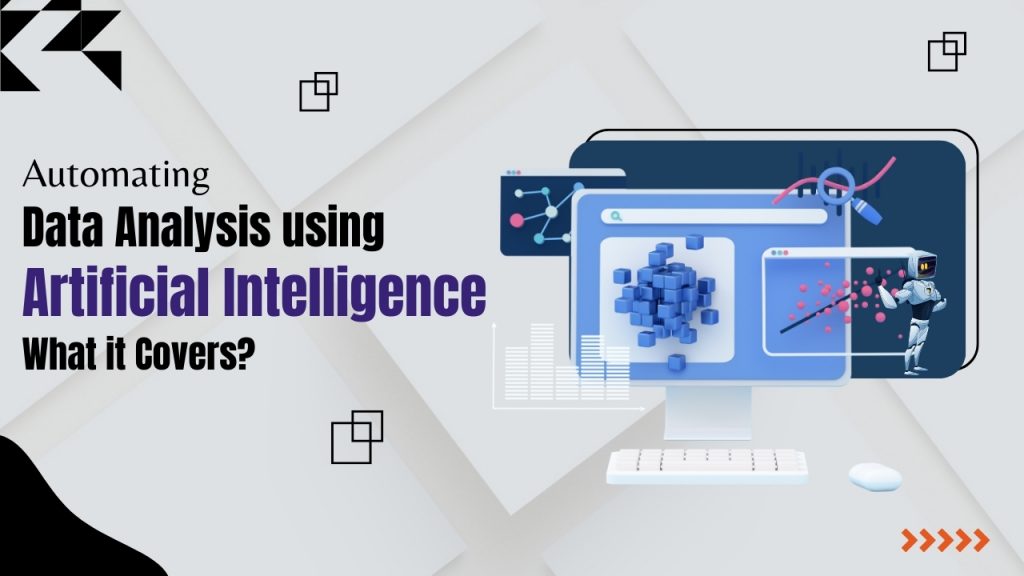Introduction
Artificial intelligence is revolutionizing businesses and how? Gartner projects that 75% of businesses will operationalize AI by the end of 2024 – which leads to a five-fold increase in streaming data and analytics infrastructures.
Thank you for reading this post, don't forget to subscribe!Interesting stats, Right?
But, the best AI use-case is automation and automation for data analysis, management, and everything beyond. With AI’s capabilities, businesses can make the most out of data and leverage it for data-driven decision-making (that is too automated).
It makes the work for data scientists, engineers, analysts, and other data professionals less complex and time-consuming.
Well, if you would like to know about more AI for automated analysis, its benefits, use cases, choosing the right AI platform for data analysis, then this blog is all you need.
Let’s get into it.
Also Read: Two Ways Data Analytics in Shaping Retail Business
What is Automated Data Analysis?
Automating data analysis entails using software tools, algorithms, and artificial intelligence to process, evaluate, and extract insights from data with no human participation. Automation of data analysis has the potential to transform the way we evaluate data in a variety of ways.
First and foremost, it can speed up the procedure. While traditional analytical methods like manual data entry, processing, and analysis can be time-consuming, automation increases productivity and allows people to spend less time on manual operations.
Also, automated data analysis technologies are less error-prone and can handle massive amounts of data more accurately than people. Data analysis tools can also automate operations including data cleaning, processing, and modeling.
The Benefits of Automating Data Analysis Using Artificial Intelligence!

- Reduced Costs & Higher Revenues
By automating data analysis, AI helps businesses cut operational costs. It reduces the need for extensive human resources dedicated to data management and lowers the expenses associated with manual data handling and reporting. Cost savings can then be reinvested into other areas that drive growth and innovation.
Apart from cost savings, AI’s ability to provide deeper insights into market trends, customer behavior, and operational performance to identify new opportunities, optimize pricing strategies, and enhance sales tactics, all of which contribute to increased profitability and market share.
Also Read: Cost-effective AI Solution for Restaurants
- Strategic Advantage
In these competitive times, businesses are giving their everything to stay ahead of the competition and get the customers to them. So, by integrating AI into their data analysis processes, businesses gain a competitive edge.
AI enables faster, more informed decisions, greater agility, and the ability to adapt quickly to market changes. This strategic advantage positions businesses ahead of their competitors, allowing them to capture market share and drive growth.
- Enhanced Accuracy
AI significantly improves the accuracy of data analysis by reducing human errors and ensuring that data handling is precise. Advanced algorithms can detect patterns, anomalies, and inconsistencies that might be overlooked manually.
With access to accurate and up-to-date data, businesses can make better strategic choices, avoid guesswork, and make data-driven decisions that align with their objectives.
- Real-Time Insights & Improved Decision-Making
AI provides real-time analysis, allowing businesses to react quickly to changes in the market, customer behavior, or operational conditions.
By continuously monitoring data streams and updating insights, AI enables businesses to make timely decisions that are aligned with current realities, enhancing their agility and responsiveness to new opportunities or threats.
Also Read: Benefits of Data-Driven-Decision-Making
- Improved Efficiency
By automating repetitive data analysis tasks, AI helps businesses free up their valuable time and resources. It enhances efficiency and reduces the need for manual intervention, streamlines operations, and minimizes delays in decision-making.
To the top of it, with AI data analysis automation, businesses can focus their efforts on strategic initiatives rather than spending time on routine data processing tasks.
- Better Risk Management
Businesses have to deal with so many risks and AI automated data analysis helps businesses cope with it effectively. AI enhances risk management by identifying potential issues and anomalies early.
It can detect fraudulent activities, supply chain disruptions, or operational inefficiencies before they escalate, allowing businesses to take proactive measures to mitigate risks. This proactive approach helps safeguard business interests and reduces financial and reputational risks.
How to Automate Data Analysis Using Artificial Intelligence?

Step 1: Collection & Integration of Data
For effective data analysis, collection & integration is the crucial step that you can’t skip. Businesses often deal with diverse data types, such as transactional records from databases, customer interactions on social media, logs from IoT devices, or unstructured data like emails and documents. The list goes on.
So, data collection is quite a time-consuming, tedious & monotonous job that also requires expertise. That’s when businesses rescue AI to automate data collection & integration.
According to a McKinsey report, businesses that effectively use AI for data integration see a 10% to 30% increase in operational efficiency.
Let’s see how
AI systems use APIs, data connectors, and web scraping tools to gather this data automatically, ensuring that it flows into a central repository without manual intervention.
By integrating data from multiple channels—such as CRM systems, e-commerce platforms, and marketing tools—AI creates a unified view of the business landscape. This integration is continuous, meaning the AI tool is always updating its data set, providing a real-time view of business operations.
Also Read: Leveraging AI to Collect Customer Insights in the Restaurant Industry
Step 2: Data Cleaning and Preparation
Suppose, you have automated the data collection and you are getting a consistent flow of updated data. But, what after that? Not all the data is useful and even if it – going through that raw data is not an easy feat and can consume a huge chunk of your business resources.
But, don’t worry – AI can even help with comprehensive data clearing and preparation so that businesses can make the most out of it. AI uses techniques such as natural language processing (NLP) to interpret text data and machine learning models to detect anomalies or outliers that may impact the analysis results.
It helps businesses remove duplicates, correct errors, fill in missing values, and normalize data formats. The AI continuously refines its data preparation processes by learning from past data corrections and user feedback, making future data preparation even more precise and efficient.
Let’s understand with an easy example:
Imagine a retail chain with multiple stores across the country, each collecting data on customer purchases, inventory levels, and sales performance. By using AI, the retail chain can automate the entire data-cleaning process.
The AI system scans through all the records to detect and remove duplicates, correct errors such as mismatched product names or wrong pricing, and fill in missing values by cross-referencing other data points (like auto-completing customer addresses from known zip codes).
This automation ensures that the retail chain’s data is accurate and reliable, making it much easier for them to analyze customer behavior, optimize inventory, and create targeted marketing campaigns.
Step 3: Data Categorization and Segmentation
To make analysis easier, AI can help businesses with data categorization and segmentation based on predefined or dynamically determined criteria. AI uses clustering algorithms to group similar data points and classification algorithms to assign data to specific categories.
AI can segment customer data based on purchase behavior, geographic location, or engagement levels.
It helps businesses identify patterns and trends within specific segments, such as understanding which customer groups are most likely to buy certain products.
The segmentation can be customized to match business goals, such as targeting a new market or optimizing a product line.
According to a Salesforce report, businesses that segment their data for targeted marketing see a 24% increase in conversion rates.
Step 4: Automated Analysis
After the thorough process of data collection, integration, cleaning, and transformation – the next step is automated data analysis. AI helps with data analysis by applying advanced machine learning models that automatically learn from historical data and apply this learning to new data sets.
These AI models help businesses by using different techniques to analyze data.
For example:
- Regression analysis reveals how different factors, like pricing or promotions, affect sales, helping businesses adjust their strategies for better results.
- Clustering groups similar customers together, so businesses can tailor their marketing efforts more effectively.
- Classification predicts which customers are likely to be interested in certain products, allowing businesses to target their offers more accurately.
This way, AI helps businesses understand their data better and make smarter decisions.
Also Read: Two Ways Data Analytics in Shaping Retail Businesses
Step 5: Data Visualization
To make the insights accessible and actionable, AI systems automatically generate visual representations such as graphs, charts, and dashboards. These visualizations help business users quickly understand complex data patterns and trends without needing to dig through raw data.
AI tools can also customize these visualizations based on the user’s role, preferences, and specific business objectives, ensuring that stakeholders see the most relevant data at a glance.
For example, a sales manager might view a dashboard highlighting sales performance metrics, while a marketing executive sees customer engagement trends. And, all these insights in an easy and appealing format help businesses make the data-driven, efficient decisions.
Let’s Understand the Spotify Way!
Spotify uses AI-driven visualizations to monitor user engagement, song trends, and platform performance metrics.
By leveraging AI, Spotify can continuously update visualizations with real-time data, which helps them quickly identify changes in listening behavior and adapt their music and marketing strategies accordingly. This real-time insight helps them maintain user engagement and grow their subscriber base(significantly).
Step 6: Generating Reports and Insights
Real-time reports and insights are also quite important for businesses to make the right decisions and improve customer experience at every step of the way.
So, beyond visualization, AI automates generating reports and insights that summarize key findings and actionable insights from the pile of data.
These reports can be tailored to meet the needs of your business different needs – which focuses on specific metrics such as key performance indicators (KPIs), or business goals of sales, marketing ROI, revenue for each quarter, and other KPIs. AI tools automatically compile these reports regularly or on demand, eliminating the need for manual report creation.
They can also provide deeper insights by highlighting anomalies, identifying potential risks, or suggesting growth opportunities based on the data.
For example, an AI-generated report might identify a sudden drop in website traffic, allowing the marketing team to understand the reason behind the same and respond quickly.
Step 7: Continuous Monitoring and Feedback Loop
You know the best part of using AI for your business decisions – it never stops. AI systems continuously monitor incoming data, ensuring the analysis remains relevant and up-to-date. As new data becomes available, AI tools automatically update models, dashboards, and reports, providing real-time insights.
This ongoing monitoring allows businesses to stay agile and responsive to changes in their environment. Moreover, AI systems incorporate a feedback loop where user actions or corrections help refine the algorithms.
For example, if a business user corrects a report’s interpretation, the AI learns from this input to improve future analyses. This feedback mechanism ensures that AI tools become smarter over time, increasing their accuracy and value.
Step 8: Automated Suggestions
The AI work doesn’t stop with giving businesses the required data, it also gives suggestions. The AI tools use sophisticated technologies and algorithms to give suggestions based on market trends, customer preferences, past history, and other things.
For instance, AI-driven analytics can link up with your marketing platforms. This means that as customer behavior changes in real-time, AI can suggest businesses adjust the marketing campaign accordingly—like increasing ad spending on popular products or targeting ads to specific customer groups.
Similarly, AI can connect with inventory management systems. It uses predictive sales data to suggest adjustments to stock levels so you’re never overstocked or understocked. For example, if AI predicts a high demand for a certain product, it can suggest to order more before you run out.
So, all in all – with AI your business is always updated on everything and can make data-driven decisions on the go.
Also Read: Choosing the Right AI Data Platform for Your Business
Choose the Best AI Platform for Automated Data Analysis!
As we have discussed, there are a lot of benefits and use cases of leveraging AI for automated data analysis. But, for that – you need to choose the right AI platform. It needs to align with what your business specifically needs, your industry easily integrates with what you already have, and be ready to grow with you.
- Do your homework. To find the right AI platform for automated data analysis, you need to do your research. For that, look for reviews, testimonials, and case studies to see how the platform has performed for other businesses like yours. A good reputation is often a sign of reliability and quality.
- Tailored Features: Look for a platform that feels like it was made for your business. It should offer tools and features that are customizable to your unique needs, whether it’s analyzing customer behavior, optimizing inventory, or forecasting sales.
- User-Friendliness: Think about your team. The platform should be easy to use, even for those who aren’t tech-savvy. An intuitive interface means everyone can get involved in data-driven decision-making, not just the data scientists.
- Integration Capabilities: Check how well the platform plays with others. It should integrate smoothly with your current systems—like your CRM, ERP, or marketing tools—so all your data flows together seamlessly, providing comprehensive insights across the board.
- Security Measures: Don’t overlook security. Choose a platform that offers robust protection for your data, including encryption, access controls, and compliance with relevant industry standards. Keeping your data safe is key to maintaining trust.
- Cost-Effectiveness: Look beyond the initial price tag. Consider all the costs, including subscriptions, maintenance, and potential upgrades. The right platform will offer great value by helping you cut operational costs and boost your bottom line. Also, make sure that there are not any hidden costs and that everything is transparent.
- Support and Training: Don’t forget about support. If you are stuck in between, then you need professional assistance to support you. And, a good platform will come with excellent vendor support, offering training, resources, and customer service to help your team make the most of it.
Well, if you are looking for one – we have got you covered. Livelytics is a one-of-a-kind feature-rich AI data platform that helps businesses with end-to-end data collection, and integration, specifically curated for industries such as hospitality, Restaurant, Salon, and Retail.
If you are looking forward to trying it for your business, you can book a free demo with us & get started.
To Conclude
Here’s the wrap on getting to know everything about AI, its automation for data analysis, and how it helps businesses. And, we hope this guide has helped you get to know better about the benefits and use cases of AI for data analysis automation.
Also, we we have stated earlier – the benefits of AI for data analysis automation are varied but it all boils down to choosing the right platform.
So, make sure you do your research and find the right one for your business. It helps you get the most out of AI and data for your business and can take your business to new heights of success.
To know more about how it practically works and helps your business, you can book a free demo with Livelytics.
